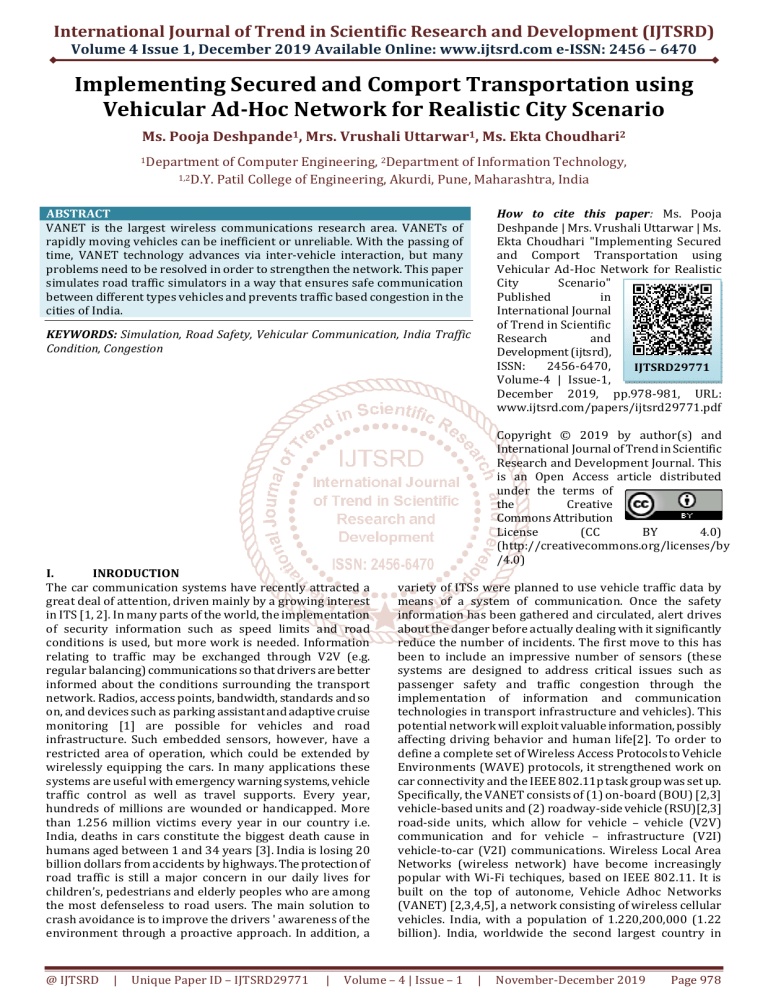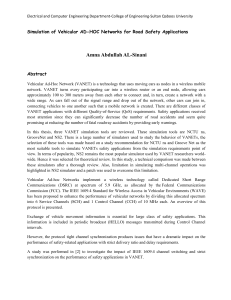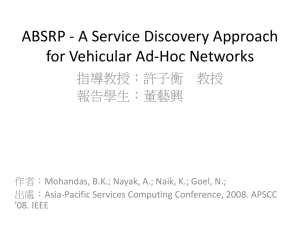
International Journal of Trend in Scientific Research and Development (IJTSRD)
Volume 4 Issue 1, December 2019 Available Online: www.ijtsrd.com e-ISSN: 2456 – 6470
Implementing Secured and Comport Transportation using
Vehicular Ad-Hoc Network for Realistic City Scenario
Ms. Pooja Deshpande1, Mrs. Vrushali Uttarwar1, Ms. Ekta Choudhari2
1Department
of Computer Engineering, 2Department of Information Technology,
1,2D.Y. Patil College of Engineering, Akurdi, Pune, Maharashtra, India
How to cite this paper: Ms. Pooja
Deshpande | Mrs. Vrushali Uttarwar | Ms.
Ekta Choudhari "Implementing Secured
and Comport Transportation using
Vehicular Ad-Hoc Network for Realistic
City
Scenario"
Published
in
International Journal
of Trend in Scientific
Research
and
Development (ijtsrd),
ISSN:
2456-6470,
IJTSRD29771
Volume-4 | Issue-1,
December 2019, pp.978-981, URL:
www.ijtsrd.com/papers/ijtsrd29771.pdf
ABSTRACT
VANET is the largest wireless communications research area. VANETs of
rapidly moving vehicles can be inefficient or unreliable. With the passing of
time, VANET technology advances via inter-vehicle interaction, but many
problems need to be resolved in order to strengthen the network. This paper
simulates road traffic simulators in a way that ensures safe communication
between different types vehicles and prevents traffic based congestion in the
cities of India.
KEYWORDS: Simulation, Road Safety, Vehicular Communication, India Traffic
Condition, Congestion
Copyright © 2019 by author(s) and
International Journal of Trend in Scientific
Research and Development Journal. This
is an Open Access article distributed
under the terms of
the
Creative
Commons Attribution
License
(CC
BY
4.0)
(http://creativecommons.org/licenses/by
/4.0)
I.
INRODUCTION
The car communication systems have recently attracted a
great deal of attention, driven mainly by a growing interest
in ITS [1, 2]. In many parts of the world, the implementation
of security information such as speed limits and road
conditions is used, but more work is needed. Information
relating to traffic may be exchanged through V2V (e.g.
regular balancing) communications so that drivers are better
informed about the conditions surrounding the transport
network. Radios, access points, bandwidth, standards and so
on, and devices such as parking assistant and adaptive cruise
monitoring [1] are possible for vehicles and road
infrastructure. Such embedded sensors, however, have a
restricted area of operation, which could be extended by
wirelessly equipping the cars. In many applications these
systems are useful with emergency warning systems, vehicle
traffic control as well as travel supports. Every year,
hundreds of millions are wounded or handicapped. More
than 1.256 million victims every year in our country i.e.
India, deaths in cars constitute the biggest death cause in
humans aged between 1 and 34 years [3]. India is losing 20
billion dollars from accidents by highways. The protection of
road traffic is still a major concern in our daily lives for
children’s, pedestrians and elderly peoples who are among
the most defenseless to road users. The main solution to
crash avoidance is to improve the drivers ' awareness of the
environment through a proactive approach. In addition, a
@ IJTSRD
|
Unique Paper ID – IJTSRD29771
|
variety of ITSs were planned to use vehicle traffic data by
means of a system of communication. Once the safety
information has been gathered and circulated, alert drives
about the danger before actually dealing with it significantly
reduce the number of incidents. The first move to this has
been to include an impressive number of sensors (these
systems are designed to address critical issues such as
passenger safety and traffic congestion through the
implementation of information and communication
technologies in transport infrastructure and vehicles). This
potential network will exploit valuable information, possibly
affecting driving behavior and human life[2]. To order to
define a complete set of Wireless Access Protocols to Vehicle
Environments (WAVE) protocols, it strengthened work on
car connectivity and the IEEE 802.11p task group was set up.
Specifically, the VANET consists of (1) on-board (BOU) [2,3]
vehicle-based units and (2) roadway-side vehicle (RSU)[2,3]
road-side units, which allow for vehicle – vehicle (V2V)
communication and for vehicle – infrastructure (V2I)
vehicle-to-car (V2I) communications. Wireless Local Area
Networks (wireless network) have become increasingly
popular with Wi-Fi techiques, based on IEEE 802.11. It is
built on the top of autonome, Vehicle Adhoc Networks
(VANET) [2,3,4,5], a network consisting of wireless cellular
vehicles. India, with a population of 1.220,200,000 (1.22
billion). India, worldwide the second largest country in
Volume – 4 | Issue – 1
|
November-December 2019
Page 978
International Journal of Trend in Scientific Research and Development (IJTSRD) @ www.ijtsrd.com eISSN: 2456-6470
terms of transport. The transportation of vehicles is most
important means of transport in India.
II.
ARCHITECTURE OF VANET
Vehicle Adoc Network (VANET) has been one of wireless
communication's most important research areas VANET's
are expected to allow the plenty of communications based
applications containing numerous in - car infotainment
systems and roadside security services, thanks to the virtue
of vehicle – by – vehicle as well as vehicle-by-infrastructure
connectivity. VANET is an MANET subset [2, 15] in which
nodes display the motion of vehicles at a high speed. That
vehicle communicates with neighboring vehicles in a highly
dynamic adhoc networking environment via wireless
networks. In the presence of RSUs, the ride-drive-through
Internet access (i.e.) may be made possible for road and
traffic conditions [15] (e.g. sharply turning heads) to be wide
cast to driver. Infotainment services can also be easily
provided via V2I communications (for example, ads, parking
and automated routing).
It would likely affect the conduct of the pilot, and strongly s
upport the use of simulation by the techniques suggested in
the broadcasting structure of VANET to IVC [2 ].
big. In addition, some obstacles such as road lights, buildings
and trees may be encountered in vehicles that lead to poor
quality of the channel and connectivity. Nevertheless, as in
MANETs, vehicle network topology is highly dynamic
because of its rapid motion and the topology of road systems
is often constrained. The topology is very dynamic. V2V
communications can also support peer to peer applications
such as information sharing and gaming. Data from mote
data servers can be supplied by the Internet backbone to a
car and vice versa. Consequently, protocols for conventional
MANETs do not deliver consistent, high outputs and low
latency in VANETs. Information about traffic shared via V2V
(e.g., regular beaconing) communications, so that drivers are
better aware of the traffic condition in the vicinity.
III.
IMPLEMENTATION AND RESULT
In the same field of research, many systems may be modeled.
Network simulation is often used for modeling computer
network architecture in the real environment long before it
is implemented. Actually SUMO [2, 23] is a discreet network
event simulator for open-source applications. Each vehicle is
specifically modeled, has its own route and travels
independently through the network. It is pure microscopic.
In such circumstances the main tool in VANET research has
now become computer simulation [11]. Simulation can be
used to compare the performance of different network
configurations to allow performance problems to be
identified and solved without the need for expensive field
testing. Traffic simulator can give the real example of the
open source, multi-modal and microscopic traffic simulation
"simulation of urban mobility" or "SUMO,"[23] as short. The
vehicle world is extremely complex and theoretical models
must not only take into account the network but also the
characteristics of the vehicles and the behavior. The
simulation allows a wide range of traffic management issues
to be addressed. Nonetheless, these models are built
independent of SUMO, only for the design of the particular
simulation module SUMO provides the required structure. It
can either be used for modeling computer networks or for
simulating network queues. It allows you to simulate the
movement through a certain road network of a given traffic
demand consisting of single vehicles.
Figure1. An illustration of a VANET
Figure 1 offers an example of a working VANET architecture.
Vehicles networks have many parallels with MANETs in
terms of flexibility, autonomy and low bandwidth. In the
event of an emergency, event-driven communications in the
danger zone (or zone of relevance, ZOR) can be created and
transmitted on the vehicles [17]. Communications solutions
unique to VANET are important. Adhoc vehicle network is a
new technology for the future on the highway. In addition,
with RSU sin place the communications service area can be
Figure2. IVC protocol is implemented in inter section
of Road to prevent from an accidents
@ IJTSRD
|
Unique Paper ID – IJTSRD29771
|
Volume – 4 | Issue – 1
|
November-December 2019
Page 979
International Journal of Trend in Scientific Research and Development (IJTSRD) @ www.ijtsrd.com eISSN: 2456-6470
Figure3: Broad Casting of Vehicles in Amravati City
(India)
integral part of our daily life, the market for car
interconnections and in-vehicle computing is on the rise. A
vehicular network used with a different profile by
applications, such as traffic administration and protection of
passengers, designed primarily for safety reasons.
VI.
REFERENCES
[1] Government of India Ministry Off Road Transport and
Highways Transport Research Wing New Delhi,
http://morth.nic.in/showfile.asp?lid=835
[2] Sommer, Christoph, et al. “On the Need for Bidirectional
Coupling of Road Traffic Microsimulation and Network
Simulation.” Proceeding of the 1st ACM SIGMOBILE
Workshop on Mobility Models - MobilityModels ’08,
2008,doi:10.1145/1374688.1374697.
[3] Stanica, Razvan, et al. “Simulation of Vehicular Ad-Hoc
Networks: Challenges, Review of Tools and
Recommendations.” Computer Networks, vol. 55, no.
14,
2011,
pp.
3179–88,
doi:10.1016/j.comnet.2011.05.007.
Figure4: Amravati City (India)
IV.
APPLICATIONS
Potential applications can be divided in two main categories
within a vehicle context, namely.
[4] Europe, United Nations Economic Commission For, and
United Nations Economic Commission for Europe.
European Agreement Concerning the International
Carriage of Dangerous Goods by Road (ADR). 2016,
doi:10.18356/e018dbc0-en.
A. Road safety
Security systems are a true way of reducing the number of
accidents considerably, primarily in order to avoid accidents.
In conjunction with the V2V-assisted adaptive cruise control,
the issue of vehicle accidents can be minimized because of a
human error.
[5] Anderson, Robert N., and Elizabeth Arias. “National
Vital Statistics Report: The Effect of Revised
Populations on Mortality Statistics for the United
States,
2000.”
PsycEXTRA
Dataset,
2003,
doi:10.1037/e509552006-001
B. Traffic monitoring and management
Traffic control and management are important if road
capacities are to be maximized and traffic congestion
avoided [6,8]. Conversely, drivers can improve their driving
routes with knowledge of traffic conditions, thereby
reducing the issue of traffic congestion (highway).
Scheduling of traffic lights can make intersections safer for
drivers. The handling of a lane changeover and/or speed
shift ensures that vehicles can go together closely but safe
[6,9]. The crossing in the city street test of intersections is
challenging and dangerous. Allowing a smooth traffic flow
will increase the traffic and reduce travel times considerably.
To improve road safety is by platooning vehicles. Fuel
savings may also benefit from a decreased smooth drag as
the vehicle's progress (i.e. less than 2 meters).
V.
CONCLUSION
The new vehicle networking model, including safety,
convenience and comfort, can be seen as promising for a
wide range of new on-road applications. VANETs can
interact with V2V and V2I. Car communications are an
essential part of a future smart transport system. Computer
simulations have been placed as the leading approach for
V2X interaction research by the difficulty of theoretical
models and the expense of actual hardware testing. Next, the
variables that vary from the modeling of a classic MANET to
the simulation of a VANET. The simulation architecture
relies on state of the art simulators from both realms,
thereby integrating well-known models for micro-simulation
of road traffic. This paper aims to promote the first step of a
vehicle interaction analysis by providing meaningful data on
the many current VANET simulators. When cars are an
@ IJTSRD
|
Unique Paper ID – IJTSRD29771
|
[6] Bakhouya, M., et al. “An Adaptive Approach for
Information Dissemination in Vehicular Ad Hoc
Networks.” Journal of Network and Computer
Applications, vol. 34, no. 6, 2011, pp. 1971–78,
doi:10.1016/j.jnca.2011.06.010.
[7] Cheng, Ho Ting “Infotainment and Road Safety Service
Support in Vehicular Networking: From a
Communication Perspective.” Mechanical Systems and
Signal Processing, vol. 25, no. 6, 2011, pp. 2020–38,
doi:10.1016/j.ymssp.2010.11.009.
[8] Nzouonta, J., et al. “VANET Routing on City Roads Using
Real-Time Vehicular Traffic Information.” IEEE
Transactions on Vehicular Technology, vol. 58, no. 7,
2009,pp. 3609–26, doi:10.1109/tvt.2009.2014455.
[9] Rahim, Aneel, et al. “Relevance Based Approach with
Virtual Queue for Vehicular Adhoc Networks.” 2009
2nd International Conference on Computer, Control
and
Communication,
2009,
doi:10.1109/ic4.2009.4909173.
[10] Bhavana, R., et al. “Performance Evaluation of Topology
Based Routing Protocols for VANETs in Urban
Scenarios.” Fourth International Conference on
Advances in Recent Technologies in Communication
and
Computing
(ARTCom2012),
2012,
doi:10.1049/cp.2012.2489.
[11] Chlamtac, Imrich, et al. “Mobile Ad Hoc Networking:
Imperatives and Challenges.” Ad Hoc Networks, vol. 1,
no. 1, 2003, pp. 13–64, doi:10.1016/s15708705(03)00013-1.
Volume – 4 | Issue – 1
|
November-December 2019
Page 980
International Journal of Trend in Scientific Research and Development (IJTSRD) @ www.ijtsrd.com eISSN: 2456-6470
[12] Deployment, Committee for the Review of The U. S.
Department of Transportation (usdot) Report on
Connected Vehicle Initiative Communications Systems,
et al. Review of the USDOT Report on Connected
Vehicle
Initiative
Communications
Systems
Deployment. 2015, doi: 10.17226/22166.
Security, vol. 15, no. 1, 2007, pp. 39–68, doi:
10.3233/jcs-2007-15103.
[19] Schoch, Elmar, et al. “Communication Patterns in
VANETs.” IEEE Communications Magazine, vol. 46, no.
11,
2008,
pp.
119–25,
doi:10.1109/mcom.2008.4689254.
[13] Hao, Jin-Kao, and Martin Middendorf. Evolutionary
Computation in Combinatorial Optimization: 12th
European Conference, EvoCOP 2012, Málaga, Spain,
April 11-13, 2012, Proceedings. Springer Science &
Business Media, 2012.
[20] Schoch, Elmar, and Frank Kargl. “On the Efficiency of
Secure Beaconing in VANETs.” Proceedings of the Third
ACM Conference on Wireless Network Security - WiSec
’10, 2010, doi:10.1145/1741866.1741885.
[14] Moon, Tae-Kyung, et al. “Integration of Car-to-Car
Communication into IAV.” SAE Technical Paper Series,
2009, doi: 10.4271/2009-01-1479.
[21] Sommer C. et al. “Simulating the Influence of IVC on
Road Traffic Using Bidirectionally Coupled Simulators.”
IEEE
INFOCOM
Workshops
2008,
2008,
doi:10.1109/infocom.2008.4544655.
[15] Moore, Tyler, et al. “Fast Exclusion of Errant Devices
from Vehicular Networks.” 2008 5th Annual IEEE
Communications Society Conference on Sensor, Mesh
and Ad Hoc Communications and Networks, 2008,
doi:10.1109/sahcn.2008.26.
[22] Weingartner, E., et al. “A Performance Comparison of
Recent Network Simulators.” 2009 IEEE International
Conference
on
Communications,
2009,
doi:10.1109/icc.2009.5198657.
[16] Moser, Steffen, et al. “Interactive Realistic Simulation of
Wireless Networks.” 2007 IEEE Symposium on
Interactive
Ray
Tracing,
2007,
doi:10.1109/rt.2007.4342604.
[17] Rahim, Aneel, et al. “Information Sharing in Vehicular
AdHoc Network.” International Journal of Computers
Communications & Control, vol. 5, no. 5, 2010, p. 892,
doi:10.15837/ijccc.2010.5.2252.
[18] Raya, Maxim, and Jean-Pierre Hubaux. “Securing
Vehicular Ad Hoc Networks.” Journal of Computer
@ IJTSRD
|
Unique Paper ID – IJTSRD29771
|
[23] Website. Simulation of Urban MObility (SUMO).
http://sumo.sourceforge.net. Accessed14 Oct. 2019.
[24] Open
Street
Map
Database
http://wiki.openstreetmap.org/wiki/.osm. Accessed 14
Oct. 2019.
[25] Yamashita, Tomohisa, et al. “Smooth Traffic Flow with a
Cooperative Car Navigation System.” Proceedings of the
Fourth International Joint Conference on Autonomous
Agents and Multiagent Systems - AAMAS ’05, 2005,
doi:10.1145/1082473.1082546.
Volume – 4 | Issue – 1
|
November-December 2019
Page 981





